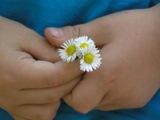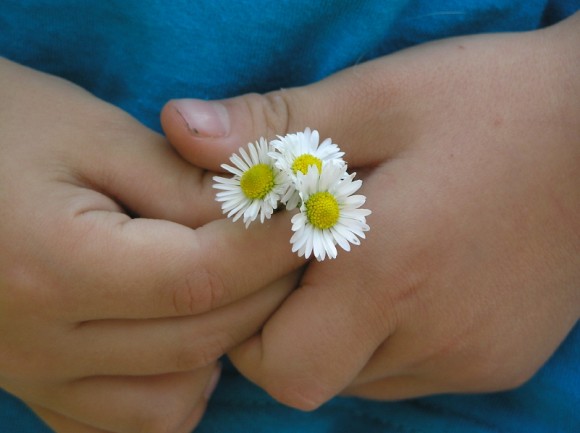Including Children in Mourning Rituals
An interview with Lauren Schneider, LCSW
Rituals, especially mourning rituals, can help create order in an environment where chaos seems to reign. When my bestie’s mama died, her little boy was three years old and very attached to his grandma. In the moments immediately following her mother’s death, my friend moved into “practical” mode, making plans to memorialize her mama’s life. An event such as this, is heavy with responsibility, but my friend’s first concern was her son. (Her mama would agree!) She questioned herself: should her boy come to the memorial? How involved should he be? How much exposure should he receive? The following interview would have answered all her questions. Lauren Schneider, LCSW, clinical director of children’s programs at Our House Grief Support Center, fills us in on the importance of including our children in mourning rituals, and the best ways to do it. — Laurel Moglen, Managing Web Editor, TMC
Why is it important to include children in mourning rituals?
When starting out in the mourning process, kids don’t have the life experience to understand about the body after death. So, if they aren’t part of anything that’s going on, they don’t understand the person is not coming back. Toddlers don’t understand the permanence of death, until they reach the next stage of cognitive development. For example, they might think the body literally flew to heaven. Being educated and prepared to participate, gives kids concrete information so they can intellectually begin to grapple with what happens when someone dies, making it less mysterious and scary. It also helps prepare and teach them about the life cycle.
If children have an adult lovingly explain that grandma has died, then their introduction to death is a much safer experience, leading to a healthier absorption of information.
How best can parents prepare and guide their child through the mourning ritual?
- Clearly, kindly and with an absence of excessive emotion, the caregiver needs to give a lot of narration about what is going to happen at the gathering, to avoid any surprises. For example, a caregiver can say, “We’re going to the cemetery, and the casket will be placed into the ground. Then we will shovel dirt on top of the casket.” The messages you send the child should be delivered in matter-of-fact way, “then after the funeral, we’ll all be together and go to lunch.”
- At the mourning event itself, have a designated trusted adult, not indispensably connected to the ritual, be the caretaker for the child. This caretaker should take the child out for breaks. Kids can’t sit still for as long as adults can, and they need breaks just due to the emotional toll.
- It’s helpful to get the clergy person involved. Before the ceremony, this leader can get down on the level of the child and ask the child to give stories to tell at the funeral. “He loved to go fishing, and get hamburgers after…” Or, for example, the Rabbi might pause during a sermon, and invite the child to come over, “soon you’ll hear a loud noise, and the tractor will lower the casket into a grave.” In a Jewish funeral, the child might take a turn putting dirt on the grave. Clergy people should be educated and on board if children are to be part of the ritual.
What are the types of unintentional mistakes parents might make?
- In general, when adults have had a traumatic mourning experience as a child, the adult is less likely to include their child.
- When a child’s attachment figures are grieving, s/he’s witnessing new and strange behavior. If the child is left at home when the attachment figures are away, for example, at the funeral and left with a babysitter or distant relative, the separation can cause lots of anxiety, confusion, and possibly feelings of abandonment. Also, later, when they find out they weren’t included in the gathering, they might have a lot of questions about what happened, like where was grandpa buried? Can I see him again? Is he okay? They also might feel angry they were left-out.
- Never force children to kiss the body, or any other thing they don’t want to do in regards to the deceased. In the olden days this was done, and can cause the child trauma.
- At the graveside, kids might want to run around. Some parents might think this is rude or inappropriate behavior, but I encourage parents to allow them to do that (under the supervision of a trusted adult not directly involved in the proceedings). Kids cope with the reality of death through play. It’s actually age-appropriate behavior.
How much information should we give our kids?
What I’ve found is, if they’re old enough to ask the question, they’re old enough to hear the answer. So, answer in kind.
For example if a child asks, what happens to grandma’s body now? You can modify the following answer depending on the age and maturity of the child, by saying something like, “in our society, people are either buried or cremated and grandpa’s body will be buried at a place called the cemetery. He won’t feel anything that happens. His body will be placed in a casket. It will stay there forever.”
When preparing a child for a funeral where the body will be viewed, you can say, “When we get to the viewing, all our family will be there. There will be a big box in front of the room, and then we’ll see grandma’s body in the box. Do you have any questions?” Little ones will say, “can I go play now?” The answer to that is yes! Allow the child to play and cope as s/he might. A seven year old might say, “will her eyes be open? Can I kiss her goodbye?” Walk them through each step of what they will experience. I want to reiterate how critical it is to ask if the child has any questions, if only because it helps parents gauge how much more or little to say. For example, the child doesn’t need to know at 4 or 5, that the body is going to decompose.
When describing a cremation, you can say, “Grandma’s body is put in a special container, and it gets really hot, and then the body melts and turns into ashes, and then we scatter the ashes in her favorite place, or put them in an urn or special box we’ll take home with us. She can’t feel anything anymore, so it won’t hurt her.”
How can we include and comfort kids during the mourning ritual?
- If parents deliver information in a matter-of-fact tone, then kids internalize the information that way.
- Some kids are offered a keepsake urn or a given a piece of jewelry with ashes in it. Some kids wear the jewelry with pride!
- These days, progressive mortuary professionals will give the child an opportunity to put something in the casket. This boy I knew made a cat for his dad before he died, and then when he died, the son placed the cat in the casket. This was incredibly comforting for him.
- A child could choose music for a video or help design a photo montage; children tend to feel proud to be included in the process.
- If you’re having a gathering, it can be helpful for the child to have the child’s teacher and classmates at the funeral or memorial. Their presence serves as a buffer to the child’s pain, by providing a familiarity, while everything else might feel chaotic and unpredictable.
Lauren Schneider, LCSW is the clinical director of children’s programs at Our House Grief Support Center. She authored Children Grieve Too: a handbook for parent’s of grieving children” and the creator of My Memory Book for grieving children.
Please share any thoughts or questions you might have about competition and kids below in the comments section. We love hearing from you!
The Mother Company aims to support parents and their children, providing thought-provoking web content and products based in social and emotional learning for children ages 3-6. Check out episodes of our “Ruby’s Studio” children’s video series, along with our beautiful children’s books, apps, music, handmade dolls, and more.
Posted in: Uncategorized
